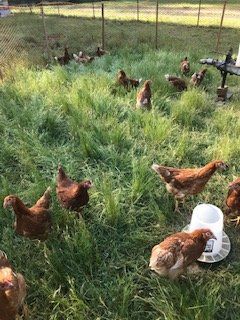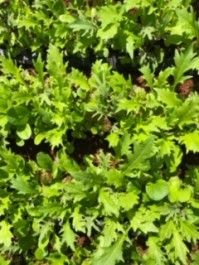I love an excuse to make a pot of soup or stew, and this wonderful rain has provided a great opportunity to do just that! Get out your recipes or check out the ones available through your Harvie account because this week is going to provide you with lots of greens.
Rainbow Swiss Chard - My favorite way to eat chard is stirred into an egg scramble for breakfast or dinner . . . or both. My scrambles are different every time and vary with whatever is in my refrigerator at the time. A little green onion and chopped chard stirred in some olive oil, add some chopped ham and then drop the egg in last for a delicious, hearty meal. Top with shredded cheese or feta cheese. Swiss Chard easily replaces spinach in any recipe.... try lasagna.
Kale – This is Toscano kale which is a flat type of kale. Sometimes its called Lacinato but both are Italian varieties. Kids like to call it Dino kale because it looks like dinosaur skin and somehow that makes it more fun to eat. I have many folks tell me they don’t like kale so I ask what has been your experience? Most folks simply buy what’s available at the grocery store and usually get very large, tough leaves, so here are some tips for picking out the best tasting kale.
1. The smaller the leaf, the more tender and sweet it will be! It doesn’t even compare to the giant kale leaves bundled at the market. I encourage you to try it when you visit the farm.
2. Kale harvested in cool weather seasons tastes entirely different than during the hot summer seasons. As the weather warms, kale becomes more bitter.
3. There are green and red varieties of kale. The red stemmed kale is more bitter than green or white stemmed kale.
4. Don’t try to eat the stems. They are really stringy and tough so remove the leaves from the stem before eating (unless it’s baby kale).
5. If you don’t like it cooked or raw, try making kale chips. Tip: Make sure you massage the leaves in some olive oil. You must break down the leaf tissue for perfect kale chips.
Onions – this week, I’ve packed both spring onions and bunching onions. In the farmer’s world, onions are categorized differently than in the retail world. Spring onions are simply immature onions that are harvested to make room for its neighbor which needs to grow larger. This is part of thinning the crop for large bulb onions, but they are delicious to eat. Bunching onions are marketed as “green onions”. They can be white or purple and the whole stem is tender enough to eat too. They are great raw or cooked.
Lettuce – I hope you are enjoying the lettuce varieties so far. Week one was a red Lollo Rossa and last week was a romaine lettuce. I'm learning more about mindful eating. Ask yourself... how do they taste different? Consider textures, flavors, appearance, aromas...all the senses. The next step is learning about how it was grown.
Our House Special Braising Greens Mix– If you follow our Facebook page, then you saw a picture of our growing braising mix. I walked the path today sampling the different leaves which surprised me with each bite. Braising mixes are becoming more popular as families incorporate more greens into the daily diet. These greens are small, tender leaves from red mustard, mizuna, tatsoi, kale and arugula plants that can be added to any salad but are more popular cooked. I’ve provided a link from @kitchn for a couple ideas. This week I put them in my bean soup. If you have received my cranberry pinto beans the past two weeks, try adding the braising mix to it for a rich and hearty soup.
What’s happening on the farm this week?
May is all about planting. Not only am I transplanting thousands of seedlings that have been growing inside since January, but also direct seeding in the field for multiple successions. Additionally, I continue to propagate seeds in the greenhouse to keep the microgreens going and protect seedlings that are waiting for much warmer weather (peppers, tomatoes, basil, etc.)
Things always need repair too. Plugged irrigation lines, holes under the fence from wildlife digging under, lights with burned out bulbs, chicken coop repairs, replacing batteries in the greenhouse thermometer, tractor fluids and lubricants need replacing, sharpening tools, etc. I easily spend a couple hours daily repairing things needed on the farm.
I finally got the irrigation installed on the asparagus bed. I finished it at dusk after a long day, but it felt so good that it was finally done knowing I wouldn't have to hand water again. Alas, I forgot about Luna! The next morning I found the tubing all chewed up so I had to do it again and build a box over the exposed line to prevent Luna from chewing it up again. Luna is still a puppy and I forget that sometimes because she’s so big. She needs lots of praise for working all night, so I try to give her my undivided attention each evening with some playtime. Sometimes we are outside together at night investigating potential threats to the livestock. Imagine…..Muk boots, raincoat and hat over pajamas with my flashlight walking around the field in the dark half asleep while Luna barks, gets me muddy, and licks me to death….yep…tis the farming life and I love it.
Have a blessed week!
Carrie



